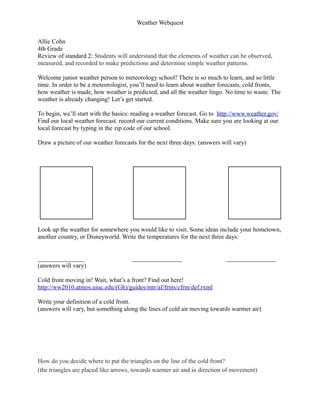
Webquest
- 1. Weather Webquest Allie Cohn 4th Grade Review of standard 2: Students will understand that the elements of weather can be observed, measured, and recorded to make predictions and determine simple weather patterns. Welcome junior weather person to meteorology school! There is so much to learn, and so little time. In order to be a meteorologist, you’ll need to learn about weather forecasts, cold fronts, how weather is made, how weather is predicted, and all the weather lingo. No time to waste. The weather is already changing! Let’s get started. To begin, we’ll start with the basics: reading a weather forecast. Go to http://www.weather.gov/ Find our local weather forecast. record our current conditions. Make sure you are looking at our local forecast by typing in the zip code of our school. Draw a picture of our weather forecasts for the next three days: (answers will vary) Look up the weather for somewhere you would like to visit. Some ideas include your hometown, another country, or Disneyworld. Write the temperatures for the next three days: _______________ ________________ ________________ (answers will vary) Cold front moving in! Wait, what’s a front? Find out here! http://ww2010.atmos.uiuc.edu/(Gh)/guides/mtr/af/frnts/cfrnt/def.rxml Write your definition of a cold front. (answers will vary, but something along the lines of cold air moving towards warmer air) How do you decide where to put the triangles on the line of the cold front? (the triangles are placed like arrows, towards warmer air and in direction of movement)
- 2. Weather Webquest Describe the types of clouds you might see as a cold front approaches, occurs, then after it passes on. (approaches: cirrus wisps, cirrostratus, cumulonimbus, occurs: cumulonimbus, passes: fair weather cumulus) Speaking of cloud, it looks like some are beginning to form! Check out this website: http://www.uen.org/weather/clouds/index.shtml Find three different kinds of clouds and draw a picture here: (answers will vary) Here comes some rain, and with it, lightening! But how exactly does lightening form? Watch this video to find out. http://www.youtube.com/watch?v=jM8h60S1GsM What do scientists compare lightening to? (a battery) How do ice particle collisions create lightening? (scientists don’t know the answer yet) All that rain is turning into snow! What conditions would we need to get a huge snowfall? Check out the weather maker at http://teacher.scholastic.com/activities/wwatch/sim/game.htm to see if you can make a giant snow storm. Record what temperatures and humidity you used to create your snowstorm.
- 3. Weather Webquest (answers will vary, but high equatorward temp, low poleward temp, and high humidity will make for the largest snowstorm) Okay junior meteorologist, it’s time to start reporting and predicting the weather. Let’s start with a weather report. Practice your reporting skills using the Weather-Tron 3030 (using a level 1). http://edheads.org/activities/weather/frame_loader.htm Write your score below. It’s okay if you don’t get a perfect score. You’re still in training! Be sure to write what you need to do next time to make sure your reports are polished when you’re on air. (answers will vary) Now it’s time to make a prediction. On the same site, go back to the main page and use the Predict-O-Matic to predict the weather. Please use a level 1 so that you can learn to use this tool. Write down your three day prediction and see if you were right! Print your score with your name and attach it to this sheet. Don’t worry about perfection, you’re just learning. (answers will vary) There is some interesting looking weather on the horizon. Solve this puzzle to see what it is. Go the this website and solve puzzle number seven by clicking the right arrow seven times. Choose easy difficulty (it’s still pretty hard! http://spaceplace.nasa.gov/weather-slyder/en/?filter=kids What weather did you make? (a hurricane) Oh no! You made a hurricane! Read the information about how hurricanes form. http://spaceplace.nasa.gov/hurricanes/en/?filter=kids Write one new thing you learned about the formation of hurricanes. Watch the video of how hurricane Katrina formed from space. Stop it at three points, beginning, middle, and end and draw what you see. Label the eye of the storm. (answers will vary)
- 4. Weather Webquest You’re almost ready to graduate, junior meteorologist! Your final stop is here to forecast some weather. Please pick two different types of weather to analyze. http://teacher.scholastic.com/activities/wwatch/analyze/ A script for your forecast will be created. Please print both of them so we can use them later in class. Congratulations! You’re a real meteorologist now! Welcome to the team, weather kid! Write the coolest thing you learned about today: If you have extra time, feel free to explore the other activities on that website on the left side bar.